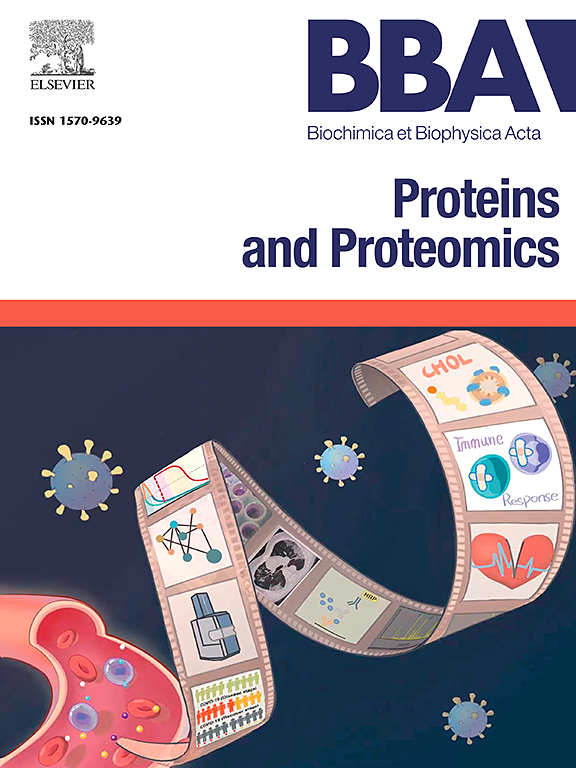DSP-1, the major fibronectin type-II protein of donkey seminal plasma is a small heat-shock protein and exhibits chaperone-like activity against thermal and oxidative stress
IF 2.3
4区 生物学
Q3 BIOCHEMISTRY & MOLECULAR BIOLOGY
Biochimica et biophysica acta. Proteins and proteomics
Pub Date : 2025-02-15
DOI:10.1016/j.bbapap.2025.141064
引用次数: 0
Abstract
Fibronectin type-II (FnII) proteins are major constituents in the seminal plasma of many mammals and play a crucial role in sperm capacitation. Additionally, the seminal FnII proteins from bull and horse exhibit chaperone-like activity (CLA), by acting as small heat shock proteins (shsps). The present work demonstrates that the major FnII protein of donkey seminal plasma, DSP-1 exhibits CLA with broad specificity and protects various client proteins such as alcohol dehydrogenase, lactate dehydrogenase and enolase against thermal and oxidative stress. Binding of phosphorylcholine (PrC) – the head group moiety of choline phospholipids, which are the physiological ligands of DSP-1 – decreased the CLA whereas binding of 1,2-dioleoyl-sn-glycero-3-phospholcholine (DOPC) increased the CLA. Biophysical studies suggested that these contrasting effects on the CLA by phosphorylcholine and diacyl phosphatidylcholine could be attributed to changes in the surface hydrophobicity of DSP-1 upon binding to these ligands. Interestingly, binding of PrC reduced DSP-1 tetramers to monomers with lower surface hydrophobicity, whereas binding to DOPC liposomes increased its surface hydrophobicity. These results, which demonstrate that DSP-1 exhibits CLA and functions as a molecular chaperone, expand the family of mammalian seminal FnII proteins that function as shsps.

DSP-1是驴精浆中主要的ii型纤维连接蛋白,是一种小的热休克蛋白,对热应激和氧化应激具有类似伴侣蛋白的活性。
纤维连接蛋白ii型(FnII)蛋白是许多哺乳动物精浆中的主要成分,在精子获能中起着至关重要的作用。此外,牛和马的精液FnII蛋白通过作为小热休克蛋白(shsps)表现出伴侣蛋白样活性(CLA)。本研究表明,驴精浆中主要的FnII蛋白DSP-1具有广泛特异性的CLA,并保护多种客户蛋白,如酒精脱氢酶、乳酸脱氢酶和烯醇化酶抵抗热应激和氧化应激。磷酸胆碱(PrC)是胆碱磷脂的头基团,是DSP-1的生理配体,它的结合降低了CLA,而1,2-二油基- asn -甘油-3-磷脂(DOPC)的结合增加了CLA。生物物理学研究表明,磷酸胆碱和二酰基磷脂酰胆碱对CLA的不同影响可能归因于这些配体结合后DSP-1表面疏水性的变化。有趣的是,PrC的结合将DSP-1四聚体还原为具有较低表面疏水性的单体,而与DOPC脂质体的结合则增加了其表面疏水性。这些结果表明,DSP-1表现出CLA和作为分子伴侣的功能,扩大了哺乳动物精液FnII蛋白家族,可以作为shsps发挥作用。
本文章由计算机程序翻译,如有差异,请以英文原文为准。
求助全文
约1分钟内获得全文
求助全文
来源期刊
CiteScore
8.00
自引率
0.00%
发文量
55
审稿时长
33 days
期刊介绍:
BBA Proteins and Proteomics covers protein structure conformation and dynamics; protein folding; protein-ligand interactions; enzyme mechanisms, models and kinetics; protein physical properties and spectroscopy; and proteomics and bioinformatics analyses of protein structure, protein function, or protein regulation.

 求助内容:
求助内容: 应助结果提醒方式:
应助结果提醒方式:


